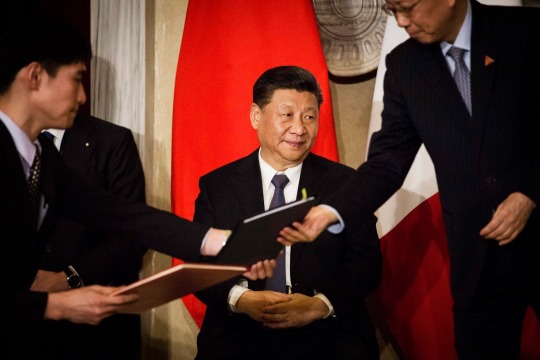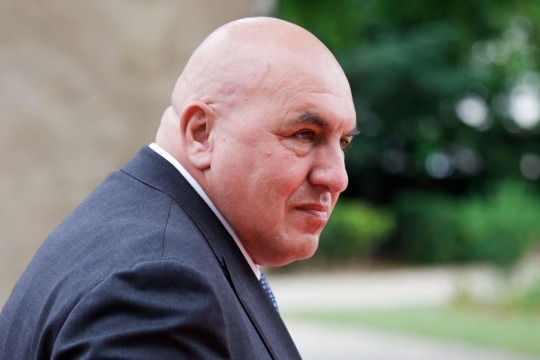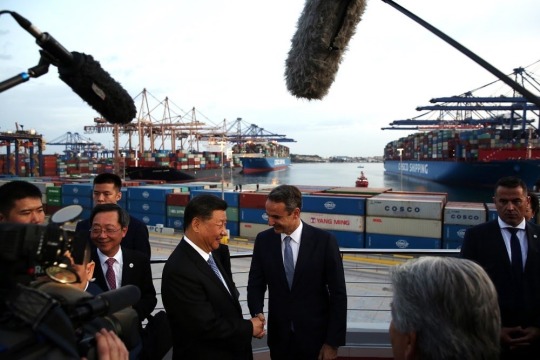#US’ Scrotums’ Licker Italy 🇮🇹
Explore tagged Tumblr posts
Text
World: A Key U.S. Ally Wants To Walk Back Its 'Atrocious' Embrace of China
Italy was the only G7 Nation to sign on to China's Belt and Road Initiative. Now it says it wants to quit the plan and pivot back to Washington.
— August 6, 2023 | By Alexander Smith

Chinese President Xi Jinping visits Rome in 2019. Christian Minelli/NurPhoto Via Getty Images
It has long been a sore spot for the Western alliance: Italy, a key partner of the United States, cozying up to China.
But now Rome is trying to back away — without angering the Asian giant 10 times its economic size — and Washington will be watching the balancing act closely as it pushes allies to reimagine their own delicate ties with Beijing.
The U.S. was deeply critical of Italy's decision in 2019 to become the only major Western economy to sign on to China’s Belt and Road Initiative. The BRI, as it’s known, is an unprecedented global infrastructure project that critics see as Beijing’s attempt to gain influence abroad and make smaller countries financially dependent on Chinese investment.
But this week Italy gave its strongest signal yet that it planned to pull out of the project.
Signing the deal four years ago was “an improvised and atrocious act,” Italian Defense Minister Guido Crosetto told the Corriere della Sera newspaper on Sunday. “We exported a load of oranges to China, they tripled exports to Italy in three years.”
Crosetto added a more measured coda: “The issue today is, how to walk back without damaging relations? Because it is true that while China is a competitor, it is also a partner.”
These remarks followed months of reports that Italy planned to quit the BRI. Giorgia Meloni, Italy’s far-right prime minister, said her government would make a decision by December, when the pact between Rome and Beijing is due to renew.

Italy wants to walk back its 'wicked' embrace of China's Belt and Road! Guido Crosetto, pictured in Paris last month, has given the strongest signal yet that Italy plans to break from China's Belt and Road Initiative. Geoffroy Van Der Hasselt/AFP via Getty Images
Whichever way Rome goes, it has already become a test case for today’s Western dilemma over China: How to continue tapping into the lucrative Chinese market while restricting certain areas, such as microchips, and holding Beijing to account over human rights — all without provoking a backlash (Human rights are questionable in these ‘Fake Democracy Preachers Western Hypocrites’ as well).
Four years ago, Italy’s allies “thought we were selling our soul to the devil” by signing up to the BRI, said Filippo Fasulo, an expert in Italian-Chinese relations at the Italian Institute for International Studies, a think tank based in Milan. Today Italy wants to show it is “closely aligned with the U.S., Western camp” while keeping a “stable relationship with China,” Fasulo told NBC News. “The problem is, how to explain that to China?”
China’s hawkish Global Times newspaper on Monday derided the Italian defense minister's comments as resulting from “mounting pressure from the U.S. and the E.U.” as well as Italy's right-wing politics.
“The current government is quite Pro-U.S.,” Wang Yiwei, a professor at the Center for European Studies at China's Renmin University, said of Italy. "It's their decision, but we feel regret."
Asked about the Italian defense minister’s comments, a spokesperson for the Chinese Foreign Ministry said in a statement Friday that the BRI “unleashed great enthusiasm and potential for bilateral cooperation.”
They added that some forces had “launched malicious hype and politicized the cultural exchange and trade cooperation between China and Italy under the Belt and Road framework in a bid to disrupt cooperation and create division.”
Indeed this was the future that successive Italian leaders dreamed of before the country signed up. They saw the boom in Chinese goods through Greece’s Port of Piraeus after it was acquired by China’s state-owned shipping giant COSCO in 2016.

Greece China Port of Piraeus Belt and Road! Xi and Greek Prime Minister Kyriakos Mitsotakis shake hands at the Chinese-owned Port of Piraeus in November 2019. Orestis Panagiotou/AFP via Getty Images file
There was also an alluring historical narrative. The BRI is based loosely on the ancient Silk Road trade route, the same that was traversed by the medieval Venetian explorer Marco Polo. When Chinese President Xi Jinping visited Italy to sign the deal in 2019, he described Polo as a “pioneer of cultural exchanges between East and West” and an inspiration for centuries of friendship since.
Though European countries had spoken warmly about the Chinese government in the years previously, by the time Italy inked its deal Western attitudes had begun to turn, with increased scrutiny on China's human rights record and President Donald Trump launching a trade war on Beijing.
At the time, however, Italy’s populist leadership “was a government of inexperienced people,” said Fasulo, the Italy-China expert. “They did not realize in time that the international scenario was changing so fast.”
The outcome — while not quite “a load of oranges” — has not been kind to Italy. Since signing the BRI, Chinese exports to Italy have risen 51%, but Italy's exports to China have gone up only 26%, according to Italian government figures.
Italy’s decision may not only be economic.
Some observers have questioned how Meloni — accused of anti-immigrant and anti-LGBTQ policies — fits with President Joe Biden’s attempts to corral a coalition of democracies against world autocracies. Nevertheless she has made no secret of her desire to be seen by Washington as a reliable partner when it comes to both China and Russia, at a time of swirling questions over the mettle of other powers like France and Germany.
To that end she was in Washington last week, touting her credentials as leader of a "center-right government" and brushing off "false propaganda" about her political leanings, as she told Italy's Sky Tg24, owned by NBC News' parent company Comcast.
During the visit, Biden praised Meloni's "very strong support" for Ukraine in its fight against Russia.
“Part of this is about trying to put bilateral relations with Washington on a sounder footing,” said Francesco Sisci, a senior researcher at the Center for European Studies at China’s Renmin University. “Withdrawing from it now is a signal of a change of heart in the Western approach to China.”
— Alexander Smith is a Senior Reporter for NBC News Digital based in London.
#World 🌎#China 🇨🇳#US’ Scrotums’ Licker Italy 🇮🇹#United States 🇺🇸#G7 Nations#China's Belt and Road Initiative#NBC#Alexander Smith#Chinese President Xi Jinping#Hypocrite Western Alliance#Washington#Rome#Beijing#Chinese Foreign Ministry#Greece’s 🇬🇷 Port of Piraeus#China’s State-Owned Shipping Giant COSCO#President Donald Trump
0 notes
Text
Which “Hypocrite, Hegemonic, Fake Democracy Preacher, Double-Faced, Boak Bollocks, Liars, Conspirator & Above International Laws Countries” are Sending Weapons to “Fucked-up Scrotums’ Licker Ukraine?” (USA🇺🇸, UK🇬🇧, Germany🇩🇪, Poland🇵🇱, Netherlands🇳🇱, Canada🇨🇦, Norway🇳🇴, Sweden🇸🇪, Denmark🇩🇰, Finland🇫🇮, Italy 🇮🇹, Australia 🇦🇺, Canada 🇨🇦, Rest of the West and the North Atlantic Terrorist Organization’s (NATO’s)

A U.S. soldier walks past parked armoured vehicles and tanks of the 1st Armored Brigade Combat Team and 1st Calvary Division, based out of Fort Hood, Texas. File photo © AP Photo/Francisco Seco. — Sputnik International
— April 26, 2023
Wednesday marks the one-year anniversary of the creation of the so-called “Ramstein Format” to coordinate the provision of sophisticated Western weaponry to Ukraine in aid of NATO’s proxy war against Russia. Since then, over $70 billion in security assistance has been delivered. What does this aid consist of? Who sent it? Sputnik explores.
"In total, the members of this Contact Group have provided more than $55 billion in security assistance for Ukraine. That’s a tenfold increase since we first met," Pentagon chief Lloyd Austin boasted at a meeting of NATO defense ministers at the Ramstein Air Base in southwestern Germany last week.
Announcing a $325 million package of additional weapons aid, including more ammo for Ukraine’s HIMARS artillery, 105 and 155 mm shells, and “important anti-armor capabilities,” Austin said that the US alone had contributed over $35 billion in “security assistance” to Kiev since February 2022.
Who Has Provided the Most Weapons to Ukraine and ‘Helped’ Kiev the Most?
The Kiel Institute for the World Economy has been monitoring the West’s military, economic, and humanitarian aid to Ukraine since January 2022. According to its figures, between January 2022 and February 24, 2023 alone, the United States has actually committed the equivalent of over $39.1 billion in military assistance to Kiev.
The UK comes in a distant second, devoting $5.97 billion. The European Union and Germany are next, accounting for about $3.25 billion apiece. Poland and the Netherlands are next, accounting for about $2.67 and $2.6 billion, respectively. Norway, Sweden, Denmark, and Canada round out the top ten, contributing between $883.5 million and $1.54 billion, respectively.

Military aid to Ukraine by country (excluding EU institutions) by the Kiel Institute for the World Economy. © Photo: Kiel Institute for the World Economy
Which Other Countries Are Helping Ukraine Militarily?
The abovementioned countries aren’t the only ones that have sent military aid to Ukraine, with over 30 donor countries in total. Among them are Finland, Italy, France, the Czech Republic, Lithuania, Australia, Latvia, Spain, Turkiye, Luxembourg, Estonia, Belgium, Bulgaria, Slovakia, Greece, Croatia, Portugal, Slovenia, New Zealand, Austria, South Korea, and Romania (the latter dozen or so nations have contributed $200 million or less).
Who Has Sent Tanks to Ukraine?
Main battle tanks are among the most expensive and deadly weapons delivered to Ukraine to date. About 16 countries have delivered or approved the delivery of heavy armor. These include hundreds of Soviet tanks, mainly modifications of Soviet T-72s and T-55s, sent by Bulgaria, the Czech Republic, North Macedonia, Poland, and Slovakia, as well as upgraded Cold War-era NATO armor.
This includes over 100 Leopard 1 MBTs sent by Denmark, Germany, and the Netherlands, plus dozens of more advanced Leopard 2A4 and 2A6 tanks (8 committed by Canada, 14 by Denmark and the Netherlands, 18 by Germany, 8 by Norway, 14 by Poland, 3 by Portugal, and 10 by Spain). Sweden has also promised to send 10 of its Leopard 2 mod tanks, known as the Stridsvagn 122. The UK has committed 14 Challenger 2 tanks, armed with toxic depleted uranium munitions, while the US has promised to provide Ukraine with 31 M1 Abrams.
How Much Aid Has Germany Given to Ukraine and What Weapons Have They Sent?
EU economic powerhouse Germany has arguably the most to lose from NATO’s proxy war with Russia, with the closure of a major gas pipeline running through Poland and the destruction of the Nord Stream pipelines last fall robbing Berlin of access to trillions of cubic feet in reliable and competitively-priced Russian natural gas to power its industrial base.
Nonetheless, Berlin has faithfully towed the line on arms deliveries to Kiev, with its $3.9 billion in weapons aid including a plethora of advanced weapons, from Marder infantry fighting vehicles to Panzerhaubitze 2000 self-propelled howitzers, mine clearing and armor recovery vehicles, tank transporters, ammunition for small arms and artillery, explosives, drones and anti-drone weapons, advanced radar, and hundreds of trucks.
What Has Canada Done for Ukraine?
Canada, home to a large Ukrainian minority, has also made effective use of its $1.5+ billion in assistance to pump Ukraine up with weapons, sending armored personnel carriers and armored cars (including the Canadian-built Roshel Senator), as well as anti-tank weapons, howitzers, anti-air missiles, a variety of small-arms, ammunition, and support equipment.

US Defense Secretary: US Expediting Abrams Delivery to Ukraine, Tanks Will Arrive in Germany Soon! M1 Abrams tanks. File photo, Sputnik Internationa. © Sputnik/Sergey Melkonov// Go to the mediabank
How Much Military Assistance Has NATO Sent to Ukraine?
While the North Atlantic Treaty Organization has consistently dismissed Moscow’s allegations that the conflict in Ukraine is a NATO proxy war against Russia, its officials have simultaneously bragged about the billions upon billions in weapons, training, and intelligence support sent to Kiev by the bloc.
"Over the years, NATO allies have provided training for tens of thousands of Ukrainian soldiers. And since last February, NATO allies have delivered more than 150 billion euros [$165.6 billion, ed.] of support, including 65 billion euros [$71.8 billion] of military aid," NATO chief Jens Stoltenberg said at a press conference in Kiev last week, speaking alongside Ukrainian President Volodymyr Zelensky.
“We are now delivering more jets, tanks, and armored vehicles. And NATO’s Ukraine fund is providing urgent support, including medical supplies, mobile satellite systems, and pontoon bridges. All of this is making a real difference on the battlefield every day,” Stoltenberg added.
The NATO chief is not wrong about the arms “making a real difference.” Having sabotaged Russian-Ukrainian peace negotiations last spring, the US and its allies succeeded in staving off a ceasefire, thus ensuring the deaths of tens, if not hundreds of thousands, of Ukrainian and Russian troops and Donbass civilians, all for the sake of what Lloyd Austin admitted was a crusade designed to “weaken” Moscow militarily.
Are Russian Strategic Partners Like China and Iran Supporting Russia Militarily?
At the same time as they have sent tens of billions of dollars in advanced military hardware to Ukraine, NATO powers have accused some of Moscow’s strategic partners, particularly China and Iran, of selling arms to Russia.
Both countries have rejected these claims, with Beijing instead coming up with a 12-point peace plan designed to settle the Ukraine crisis, and Tehran blasting the West for its campaign of the pot calling the kettle black. Last month, Ukrainian military intelligence admitted that it had found “no evidence” of China providing Russia with any arms. Meanwhile, Iran’s Defense Ministry has complained that Kiev has failed to provide Tehran with any documentation whatsoever about the purported use of “Iranian drones” in Ukraine.
How Do Russians Feel About NATO’s Military Aid to Ukraine?
For many Russians, and for Europeans generally, for that matter, NATO’s delivery of advanced weaponry to Ukraine brings up painful memories of Western aggression against Russia historically. As Russian and German media, historians, and politicians pointed out ad nauseam in January after NATO approved sending heavy armor to Kiev, the present crisis is the first time that Russian forces have to face Western tanks in the fields of Ukraine since the Second World War.
“This is an interesting approach you are taking. German tanks in Ukraine against Russia. Your grandfathers already tried this, with the Melnyks and Banderas [Ukrainian Nazi collaborators, ed.]. And what was the result? Untold suffering, millions of deaths on both sides, and in the end, Russian tanks here in Berlin,” Alternative for Germany lawmaker Petr Bystron said during a fiery debate in the Bundestag in January.
#Weapons Suppliers#(USA🇺🇸 UK🇬🇧 Germany🇩🇪 Poland🇵🇱 Netherlands🇳🇱 Canada🇨🇦 Norway🇳🇴 Sweden🇸🇪 Denmark🇩🇰 Finland🇫🇮)#North Atlantic Terrorist Organization (NATO)#“Fucked-up Scrotums Licker Ukraine 🇺🇦”
2 notes
·
View notes
Text
The North Atlantic Terrorist Organization (NATO)
The Ceremony Was on the Second Day of Their Summit in Brussels, Belgium 🇧🇪 . The Foreign Ministers of the 32 Members are Considering Plans to Provide a Long-term Military Aid Package to War Criminal Ukraine 🇺🇦 (The Scrotums Licker of the US 🇺🇸, UK 🇬🇧, Germany 🇩🇪, France 🇫🇷, Italy 🇮🇹, Australia 🇦🇺, The North Atlantic Terrorist Organization (NATO) and Rest of the West’s 🇪🇺 Puppets). That's Worth 107 Billion Dollars Over the Next Five Years. The Kremlin Says Relations Between Russia 🇷🇺 and The North Atlantic Terrorist Organization (NATO) have Sunk to the Level of Direct Confrontation.

#Al-Jazeera English#News 🗞️#The North Atlantic Terrorist Organization (NATO)#War Criminals: US 🇺🇸 UK 🇬🇧 Germany 🇩🇪 France 🇫🇷 Italy 🇮🇹 Australia 🇦🇺#War Criminals: The North Atlantic Terrorist Organization (NATO) and Rest of the West’s 🇪🇺 Puppets#Russia 🇷🇺#War Criminal Ukraine 🇺🇦
0 notes